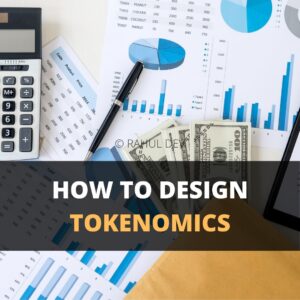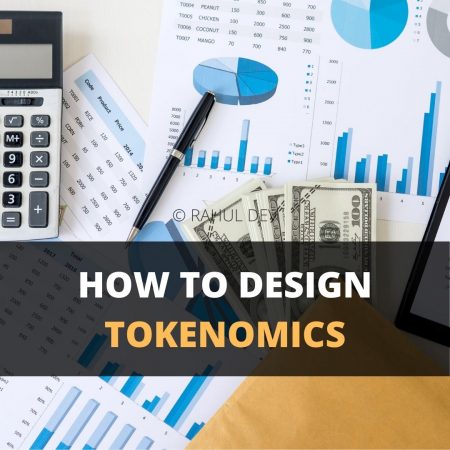Design Token Economics
Explore the Process to Develop Tokenomics

Understand Practical Aspects
Understand how to launch Blockchain Projects and Utility Tokens

Explore the Process to Develop Tokenomics

Understand how to launch Blockchain Projects and Utility Tokens

Protect your innovations across multiple countries and create strong patent portfolio to boost business valuation
Local and global brand protection through international trademark registrations
Extensive research and business writing for technical whitepapers and B2B content products
In the world of blockchain and cryptocurrency projects that include utility tokens, tokenomics refers to a combination of token and economics. This article aims to provide a technical guide to design tokenomics and develop token economics of utility tokens or digital assets in blockchain projects. Specifically, tokenomics cover a wide range of project features, including, the rules, incentives, and money systems that control how digital assets work and how much they’re worth in terms of the business valuation. Demonstrating the blockchain project’s technology advances and economic principles, along with financial dynamics, is the best way to plan and build tokenomics. This will ensure the long-term viability and value growth of digital assets related to the cryptocurrency project and asset tokenization projects.
These important components of tokenomics work together to provide a foundational framework for launching a cryptocurrency or a utility token or a digital asset, which is to be created, distributed, and managed within the blockchain ecosystem. The specific elements of tokenomics include, token supply representing the total number of tokens in existence, various distribution methods covering mechanisms for allocating tokens like ICOs, mining, staking, or airdrops, and the token’s utility that defines the functional use of tokens within the ecosystem such as governance or payment rights along with the value of the utility tokens.
This article covers following topics:
Role of Tokenomics in Project Success
Designing Token Supply and Distribution
Developing Token Utility with Tokenomics
Developing Effective Tokenomics Models
Patent Landscape Analysis in Tokenomics
Patent Drafting For Innovative Tokenomics

A cryptocurrency trading platform’s architecture consists of several main components, including a Trading Engine as the heart of your platform, responsible for matching orders and executing transactions; a Multi-Cryptocurrency Wallet Generator to create and manage user wallets for a variety of cryptocurrencies, a User Interface (UI); various security measures that use multi-layered security protocols such as two-factor authentication (2FA) and cold storage solutions, along with an API Layer to enable seamless interface with external services and systems, hence improving functionality. Essentially, this step is followed by selecting a strong tech stack for both web and mobile development of the crypto trading platform, taking into account popular frameworks such as React or Angular for front-end and C or PHP for back-end development.
Tokenomics is key to blockchain project success. It includes token economic model design and execution in a project ecosystem. Tokenomics affects user behavior, project sustainability, and market dynamics, according to academic and business studies. Tokenomics can increase community involvement, liquidity, and value creation by harmonizing token distribution, utility, and governance incentives. Tokenomics design must balance supply, demand, utility, and governance. Research reveals that a well-designed tokenomics model can promote network effects, reward desired behaviours, and reduce token manipulation and market volatility. To protect investors and market integrity, tokenomics design regulations stress openness, fairness, and compliance.
In addition, tokenomics is crucial to funding and project development. ICOs, token sales, and distribution events frequently follow the tokenomics framework. Projects with tokenomics that match corporate goals, user demands, and market conditions are more likely to attract investment, establish a community, and succeed. Tokenomics changes blockchain projects’ foundation and growth by merging economics, game theory, and behavioral incentives. Project teams must understand tokenomics and develop solid economic models to compete, innovate, and give value to stakeholders while launching token projects in the evolving blockchain ecosystem.
The process of determining token supply is a crucial element of tokenomics, necessitating a careful equilibrium between rarity and availability. Important factors to consider are the overall supply, which determines scarcity and can affect value, the circulating supply that impacts liquidity and price movements, and the maximum supply, which establishes a limit to manage inflation. Market demand projections, intended utility, and comparative analyses with similar projects are crucial factors that heavily influence the decision-making process.
At this stage, having clear and open distribution strategies is crucial for establishing trust and ensuring fair access to tokens. Generally, various regularly employed techniques encompassing Initial Coin Offerings (ICOs), private sales, airdrops, staking rewards, and mining are well-known. Essentially, Initial Coin Offerings (ICOs) serve as a means for enterprises to secure capital, necessitating transparency about the allocation of funds, duration of their retention, and adherence to regulatory frameworks. Private sales and airdrops are specifically tailored to meet the needs of specific investment groups or community members, typically with specific requirements such as length of lock-up. The provision of staking rewards and mining serves as a means to motivate users to engage actively in the network through the validation of transactions and the maintenance of network security.
Following best practices requires effective communication of distribution rules, implementation of measures to prevent manipulation, and ensuring strategies are aligned with long-term utility and governance structures. Developing successful tokenomics requires a careful and thorough approach that takes into account economic principles, market dynamics, and project objectives. By emphasizing token supply, distribution strategies, and utility fundamentals, developers can build strong tokenomics models that promote long-term growth, encourage user participation, and drive innovation in the digital asset ecosystem.
Token utility is a cornerstone in driving demand and relevance within an ecosystem. It encompasses various forms such as governance, where token holders can influence project decisions, access rights granting privileges within the ecosystem, and the use of tokens as payment methods for transactions, fees, or purchases, enhancing liquidity and usage. To increase a token’s value over time, several mechanisms can be employed. Staking encourages holding tokens to support network operations, with rewards distributed for participation, potentially reducing circulation and increasing value. Burn mechanisms involve periodically removing tokens from circulation to create deflationary pressure, while rewards distributed to users for engagement activities contribute to network growth and utility.
An analysis of prosperous initiatives such as Ethereum and Binance Coin uncovers shared patterns in their tokenomics architecture. Ethereum 2.0’s adoption of Proof of Stake (PoS) highlights the importance of sustainability and staking rewards. On the other hand, Binance Coin’s utilization of burn mechanisms and utility throughout the network demonstrates successful ways for creating value. The challenges in tokenomics cover issues such as excessive complexity, lack of alignment of incentives, and regulatory errors. In order to circumvent these drawbacks, tokenomics should give precedence to simplicity and clarity, guaranteeing effortless comprehension and communication. To ensure successful implementation of tokenomics, it is essential to create token incentives that are in line with the long-term health of the ecosystem and to remain alert to legislative changes in order to adjust compliance tactics.
Patent searching is an essential component of tokenomics as it guarantees that novel elements of token design do not violate pre-existing patents. Through comprehensive patent searches, blockchain projects have the ability to detect possible conflicts of intellectual property, reduce legal liabilities, and safeguard their distinctive tokenomics models against allegations of infringement. A project that is in the process of developing an innovative staking mechanism for token rewards, for instance, is required to undertake patent searches to ensure that no other entity has already patented their method.
Patent drafting plays a crucial role in the realm of tokenomics by serving as a means to record and safeguard innovative concepts, algorithms, or mechanisms that support the economic framework of the undertaking. By employing thorough and extensive patent drafting practices, blockchain project owners can protect the intellectual property rights associated with their innovative tokenomics approaches. An example of this is when a project intends to develop a novel governance system for utility tokens. In order to prevent unauthorized duplication of their distinctive governance mechanisms, the project must file patent applications.

As a business coach and thought leader, I cannot emphasize enough the importance of innovation, new software patents, mobile apps, and patents for tech companies, startups, and entrepreneurs. The world is rapidly evolving, and staying ahead of the curve is vital for success. Embracing technological advancements such as blockchain and AI can unlock unprecedented opportunities, streamline operations, and propel businesses into the future with competitive valuation via intangible assets.
Click Here for AI Startup Valuation Guide.
For instance, blockchain technology can revolutionize supply chain management and secure data sharing wherein innovative business models are explained to the audience via technical whitepapers, while AI can automate and optimize decision-making processes. Mobile apps are no longer just a luxury; they have become essential tools for engaging customers and offering personalized experiences. Furthermore, securing digital innovation patents is crucial for protecting intellectual property, fostering innovation, and maintaining a competitive edge. By investing in these areas, businesses can position themselves as industry pioneers and pave the way for a prosperous future after thoroughly conducting the due diligence and reviewing the legal opinion letters, which in case of digital assets can assist in determining the tokens as utility assets or coins as utility tokens before listing the assets at an exchange.
Our team of advanced patent attorneys assists clients with patent searches, drafting patent applications, and patent (intellectual property) agreements, including licensing and non-disclosure agreements. Advocate Rahul Dev is a Patent Attorney & International Business Lawyer practicing Technology, Intellectual Property & Corporate Laws. He is reachable at rd (at) patentbusinesslawyer (dot) com & @rdpatentlawyer on Twitter.
Quoted in and contributed to 50+ national & international publications (Bloomberg, FirstPost, SwissInfo, Outlook Money, Yahoo News, Times of India, Economic Times, Business Standard, Quartz, Global Legal Post, International Bar Association, LawAsia, BioSpectrum Asia, Digital News Asia, e27, Leaders Speak, Entrepreneur India, VCCircle, AutoTech).
Regularly invited to speak at international & national platforms (conferences, TV channels, seminars, corporate trainings, government workshops) on technology, patents, business strategy, legal developments, leadership & management.
Working closely with patent attorneys along with international law firms with significant experience with lawyers in Asia Pacific providing services to clients in US and Europe. Flagship services include international patent and trademark filings, patent services in India and global patent consulting services.
Global Blockchain Lawyers (www.GlobalBlockchainLawyers.com) is a digital platform to discuss legal issues, latest technology and legal developments, and applicable laws in the dynamic field of Digital Currency, Blockchain, Bitcoin, Cryptocurrency and raising capital through the sale of tokens or coins (ICO or Initial Coin Offerings).
Blockchain ecosystem in India is evolving at a rapid pace and a proactive legal approach is required by blockchain lawyers in India to understand the complex nature of applicable laws and regulations.